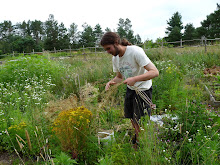Now that I have the garden reasonably under control I've been working on stringing together the yurt poles into the wall sections. The poles are attached simply by drilling holes spaced exactly 12" apart and tying a short length of twine through the holes. The plan for my 14' yurt calls for three wall sections, two of which I've completed while the third is under construction. After the leaves fall in October I'll cut a nice, straight ash tree in the forest for the tono wheel. I'll cleave it into two planks with a froe which will then be steamed to form the wheel. The roof poles are now oiled and finished, they just need to be cut to length and have their taper made once the tono wheel is complete (the wheel has to come first). I'm hoping the whole thing will be finished sometime this fall, maybe late-October or November.
An interesting concept that I'm building into the yurt is to have at least one pole representing every hardwood species in our forest (minus the rare ones which I wouldn't want to cut and weaker woods like aspen). So far I have red maple, sugar maple, striped maple, white ash, red oak, white oak, paper birch, grey birch, american beech, american elm, linden, speckled alder and black cherry, though the bulk of the poles are ash and maple. It's kind of a symbolic gesture that celebrates the unique diversity of the Acadian forest. When you think about it, a yurt is just about the lowest impact form of shelter when it comes to materials needed from the ecosystem. In all it takes just a few big armloads of biomass (biological wealth) taken out of the forest to fashion a warm, dry shelter (human wealth). Contrast that to a new house. And when the organic based yurt has finally reached the end of its life it can be wholly returned to the earth, the atoms and minerals of which may continue their cycle in a tree, another yurt, a salamander or a human being...
Saturday, June 27, 2009
Subscribe to:
Post Comments (Atom)



No comments:
Post a Comment